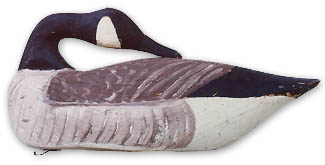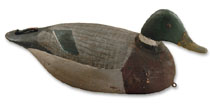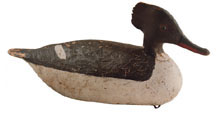by James L. Trimble
 The Chesapeake Bay diamondback terrapin, a reptile, is distinguished by the diamond-shaped concentric rings on the scutes of its upper shell. Saltwater predators that hibernate under water during the cool winter months, they emerge in the spring to eat, mate, nest and bask in the warmth of the sun. The diamondback feeds on crabs, mussels, snails and other saltwater creatures as well as aquatic plants. The Chesapeake Bay diamondback terrapin, a reptile, is distinguished by the diamond-shaped concentric rings on the scutes of its upper shell. Saltwater predators that hibernate under water during the cool winter months, they emerge in the spring to eat, mate, nest and bask in the warmth of the sun. The diamondback feeds on crabs, mussels, snails and other saltwater creatures as well as aquatic plants.
Chesapeake Bay colonists prepared terrapin as learned from the Native peoples of this region, roasted whole buried in live coals. Since terrapins were abundant and easy to catch, early Chesapeake Bay landowners fed their indentured servants and slaves a staple diet of its meat. The Hibernian Society of Baltimore has featured terrapin at almost all of its St. Patrick’s Day dinners since the local chapter was founded in 1803.
After the Civil War, as business tycoons built great fortunes during the Industrial Revolution, East Coast plutocrats sought delicacies to impress their friends. Terrapin, rich in flavor, was greatly appreciated as gourmet food by the late 19th century, especially in a stew laced with cream and sherry or port. Increasingly sought by the grand and the great, it became the food of socialites and topped the menu at most fine East Coast restaurants, hotel dining rooms and private clubs. Rising prices only stimulated demand.
From 1850 to 1920 prices for terrapin soared, rising from $6 to $128 per dozen. Chesapeake Bay watermen had trouble meeting the demand as populations depleted. Since the soup or stew was made with sherry or port, it was "drunk" with light spirits. Thus Prohibition, the 18th Amendment to the Constitution, proved its savior. Without readily available alcohol to enhance its flavor, the popularity of the dish plummeted. Except for a few East Coast restaurants and a handful of private clubs, terrapin was literally knocked from the top of the menu, allowing several generations of these sea turtles to replenish the population.
This also allowed Miles Hancock, a waterman from Chincoteague, Virginia, to continue the tradition, and he supplied terrapin to East Coast markets for over 60 years.
Miles Henry Hancock was born in 1887 at the family home in Williamsville, Delaware, just north of the Maryland line on the Delmarva Peninsula. He was the son of a farmer and had a brother and two sisters. His mother died while the children were still young. Hancock was six or seven years old when his father, with four children, moved to Chincoteague Island in Accomac County, Virginia. Apparently unable to provide for the family, he placed the children in foster homes.
 Hancock often gunned from his small boat on Chincoteague Bay, leaving the shore with long stemmed branches stacked high in the bow. Once anchored in shallow water, he stuck the branch stems in the bay’s muddy bottom. The brush concealed the boat and its gunner. This method proved ideal for hunting divers. Hancock often reminisced, "back when the skies were filled with waterfowl, on my best day, I bagged 52 redheads with five shots." He also claimed to have once killed 106 broadbills in two hours of shooting. He was also quoted in another newspaper as saying "ducks were my living…there were no game laws…the country was young and hungry…we filled a need." Hancock often gunned from his small boat on Chincoteague Bay, leaving the shore with long stemmed branches stacked high in the bow. Once anchored in shallow water, he stuck the branch stems in the bay’s muddy bottom. The brush concealed the boat and its gunner. This method proved ideal for hunting divers. Hancock often reminisced, "back when the skies were filled with waterfowl, on my best day, I bagged 52 redheads with five shots." He also claimed to have once killed 106 broadbills in two hours of shooting. He was also quoted in another newspaper as saying "ducks were my living…there were no game laws…the country was young and hungry…we filled a need."
The U.S./Canada Migratory Waterfowl Act of 1917 put a stop to Hancock’s market hunting activities. Like most other market gunners of the day, he turned to providing guide services for wealthy East Coast sports. Hancock had a reputation as a knowledgeable waterman who knew how to kill ducks and his services were greatly sought out.
 Initially Hancock made decoys for market hunting, strictly for personal use, but now he provided rigs for his gunning parties. He regularly refurbished the rigs and carved heads to replace those busted in use. Around 1920 he began helping Ira Hudson, the Island’s most prolific decoy maker, fill orders. Hudson, like Hancock, was a transplant from Sussex County, Delaware. Their families lived in the same community of Williamsville just three miles west of the Delaware seashore. Their baptism and family records can be found at the only church in that tiny community. According to family members, Hancock gave his first decoy to his mentor, who was 14 years older, and Hudson returned it many years later to one of Hancock’s children. Initially Hancock made decoys for market hunting, strictly for personal use, but now he provided rigs for his gunning parties. He regularly refurbished the rigs and carved heads to replace those busted in use. Around 1920 he began helping Ira Hudson, the Island’s most prolific decoy maker, fill orders. Hudson, like Hancock, was a transplant from Sussex County, Delaware. Their families lived in the same community of Williamsville just three miles west of the Delaware seashore. Their baptism and family records can be found at the only church in that tiny community. According to family members, Hancock gave his first decoy to his mentor, who was 14 years older, and Hudson returned it many years later to one of Hancock’s children.
Hancock’s early decoys reflect a strong Hudson influence. The bodies are round and exhibit Hudson’s stylized paddle tail. A rig of Hancock’s early round-bodied broadbills, painted as wigeons in original Hudson paint, have survived. It wasn’t until the late 1940s or early 1950s that he developed the wider, flat-bottomed style that was used on the majority of his carvings.
Hancock made his decoys out of whatever wood was available, first cedar, then cottonwood and eventually balsa. They were hand chopped and finished with a drawknife, spoke shave and pocket knife. The decoys were painted with flat house paint, sometimes with scratch feather patterns, and then tack eyes were affixed. His lead ballast weights were sand cast, some with the initials of the owner or club markings if requested. The loop to attach the anchor line on many of his decoys was fashioned from TV antenna wire. Roof top TV antennas sprouted like mushrooms throughout the United States after World War II.
Hancock made decoys of most of the ducks that frequent the Atlantic Flyway, as well as Canada geese, brant and a few swans. His miniature carvings weren’t made until his later years. Neither sleek nor fancy, his decoys have a definite folk art appeal.
A special thanks to Miles Hancock’s daughter, Helen Gaskins of Chincoteague; Grayson Chesser of Sanford; and Bob Booth of Modest Town, all communities on the Eastern Shore of Virginia; and Ray Yingling of Baltimore.
For the complete story, please see the Sept./Oct. 2000 issue of Decoy Magazine.
Tidbits Main Index

|


